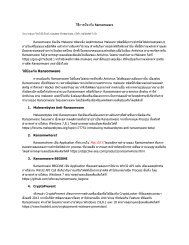Create successful ePaper yourself
Turn your PDF publications into a flip-book with our unique Google optimized e-Paper software.
Habitat Loss<br />
The main threat facing Asian wild elephants is loss of habitat,<br />
which then results in human-elephant conflict. In South East<br />
Asia, an ever-increasing human population has led to many<br />
illegal encroachments in elephant habitats. Many infrastructure<br />
developments like roads and railway tracks also fragment<br />
habitat. Elephants become confined to “islands” as their<br />
ancient migratory routes are cut off. Unable to mix with other<br />
herds, they run the risk of inbreeding.<br />
Habitat loss also forces elephants into close quarters<br />
with humans. In their quest for food, a single elephant can<br />
devastate a small farmer’s crop holding in a single feeding raid.<br />
This leaves elephants vulnerable to retaliatory killings,<br />
especially when people are injured or killed<br />
Facts about elephants :<br />
Asian elephants are extremely sociable, forming groups of six<br />
to seven related females that are led by the oldest female, the<br />
matriarch. Like African elephants, these groups occasionally<br />
join others to form herds, although these associations are<br />
relatively transient.<br />
When you look at elephants, the first thing that strikes you<br />
may be their large floppy ears. Actually, this is how you identify<br />
an African elephant from an Asian elephant, whose ears are<br />
a bit smaller and rounded. Elephants’ears provide more than<br />
hearing: they are equipped to provide heat relief. A network of<br />
tiny veins carries blood to the rest of the body. When they are<br />
hot, they flap their ears and the blood running through the ears<br />
is cooled in the process.<br />
The elephant’s trunk is the second thing that brings up many<br />
questions. An elephant’s trunk is actually a long nose with many<br />
functions. It is used for smelling, breathing, trumpeting, drinking<br />
and also for grabbing things -especially a potential meal. The<br />
trunk alone contains about 100,000 different muscles. Next to the<br />
trunk are the tusks, which have them brought a lot of problems<br />
because of the ivory. All Africans elephants grow tusks, but only<br />
some male Asian elephants have tusks. Some female Asian<br />
elephants have very tiny tusks called tushes but no longer tusks.<br />
The trade of ivory is illegal today, but it has not been completely<br />
eliminated.<br />
The perfect day for an elephant should be spent feeding<br />
on grasses, but large amounts of tree bark, roots, leaves and<br />
small stems are also eaten. Cultivated crops like bananas, rice<br />
and sugar cane are favorite foods. Elephants always need to<br />
be close to a source of fresh water because they need to drink<br />
a lot.<br />
Being the largest land animals on earth, elephants can weight<br />
up to four tonnes and reach more than three metres tall. But<br />
this impressive size hasn’t prevented us from bending them to<br />
our will. Despite having some protection in Thailand, elephant<br />
populations have vastly declined over the past 100 years due<br />
to many factors such as habitat destruction, poaching, climate<br />
change, human action, etc... Nowadays, there are only about<br />
3,000 to 4,000 elephants remaining in Thailand. The notion of<br />
extinction is no longer just a concern, it is the new reality.<br />
As Graydon Carter said: “We admire elephants in part<br />
because they demonstrate what we consider the finest human<br />
traits: empathy, self-awareness and social intelligence. But the<br />
way we treat them puts on display the very worst of human<br />
behavior.”<br />
10 11

















